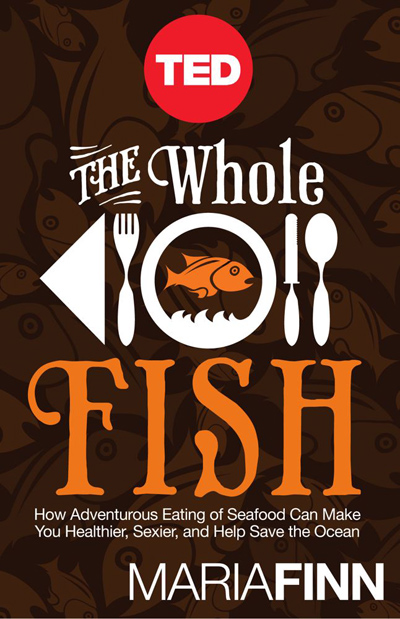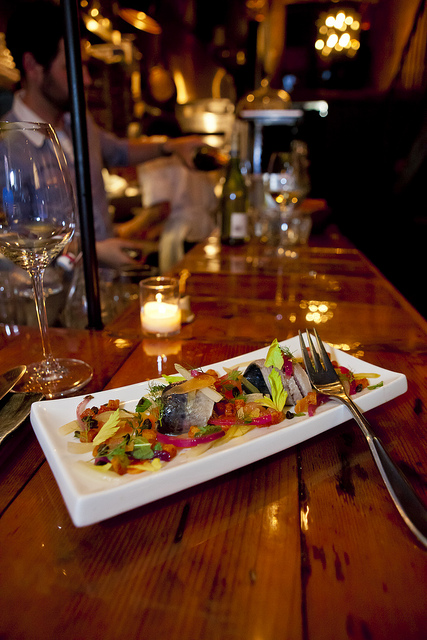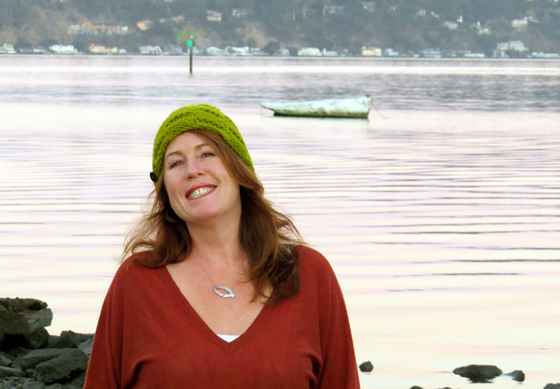
Having worked on commercial salmon fishing boats in Alaska, Finn knows her salmons, from the big, meaty chinooks (great for grilling) to the mild, soft-fleshed pinks (perfect for burgers or croquettes), and she starts the book with a vivid description of the opening of the Alaskan salmon season, the boats jostling like racehorses waiting for the starting gun. Finn has also worked in resource management for the Alaska Department of Fish and Game, plunging into frigid water in a wetsuit to count salmon runs, then camping alongside the river through long tundra twilights in utterly remote locations.
Her first-hand experiences pepper the book, giving depth to her impassioned pleas for dam reduction; sound, non-polluting aquaculture and hatchery practices; and putting into practice an everyday environmental consciousness of the complexity of the ocean-to-river food web.
Several of the essays in the book are based on Bay Area Bites' pieces that Finn wrote over the past year, including a recent piece about foraging for fish in San Francisco Bay and grilling whole salmon. The book ends with recipes focusing on lesser-known salmon parts, from bones to collar; forage fish, like squid, mackerel, sardines, and herring; and sustainably-farmed fish, including catfish, white bass, trout, and local tilapia.
This Sunday, October 28, from 11am-4pm, you can meet Maria to talk fish and fishing while chowing down on some delicious roasted wild California chinook salmon with local chanterelle mushrooms and Rancho Gordo cannellini bean salad, sourced by Martin Reed of I Love Blue Sea and cooked by John Fink of The Whole Beast at this month's final Picnic at the Presidio, sponsored by Off the Grid.

Sardines with Grapefruit, Mint, and Marinated Vegetables. Photo: Quan Pham Photography courtesy of Bouche
Sardines with Grapefruit, Mint, and Marinated Vegetables
This recipe comes from Chef Nicolas Borzee of Bouche in San Francisco. Borzee is from Alsace, France, and began working in restaurants at the age of 15. He worked his way through some of the best kitchens in France, including L’Atelier of Joel Robuchon. He moved to San Francisco in part for the local, sustainable ethos and amazing fresh ingredients, but also because of the passion for food. “There was so much love,” he said. “I’d never heard anyone talk about their muse that way.”
Prep Time: 30 minutes, plus 14 hours' marinating time
Cook Time: 30 minutes
Total Time: 1 hour, plus 14 hours' marinating time
Yield: Serves 2
Ingredients:
8 fresh sardine fillets
5 pink grapefruits
1 fennel with greens
1 celery stalk with yellow leaves
2 baby carrots with greens
1 red onion, peeled
1 branch chocolate mint (from the farmers’ market)
4 tablespoons capers
4 ounces pain de mie (4 slices from a high quality sandwich-type white loaf)
2 ounces (1/4 cup) freshly squeezed lemon juice
1 pinch Espelette pepper
1 pinch garam masala
4 ounces (1/2 cup) olive oil
2 ounces (1/4 cup) rice vinegar
Salt to taste
Preparation:
- Wash the sardine fillets with cold water and dry them. Place the fillets on a tray and marinate for 2 hours with a pinch of salt per sardine and 2 ounces of lemon juice.
- Peel and finely cut the vegetables. Bring a pot of water to a boil. Add several tablespoons of salt. Blanch vegetables for 1 minute, then drain. Reserve the greens of the carrots and fennel along with the yellow leaves of the celery stalk.
- Take 1 grapefruit, remove the peel and membrane, and cut the flesh into small squares. Juice the remaining grapefruits. Reduce the juice in a pot by one third and season it with 2 ounces of rice vinegar, 4 ounces of olive oil, and salt to taste. Once the reduction has cooled, add all the vegetables and the sardines and marinate for at least 12 hours.
- In a deep fryer, fry the capers.
- To make the croutons, cut the pain de mie into small squares and sauté in a pan until they are dry. Season with a pinch of Espelette pepper and a pinch of garam masala.
- On a plate, place three sardine fillets in the middle and garnish with the vegetables, greens, fried capers, croutons, and mint.
Beverage pairing:
Chateau d’Esclans, Les Clans Rose 2008. This is an organic rosé from Provence, France.


